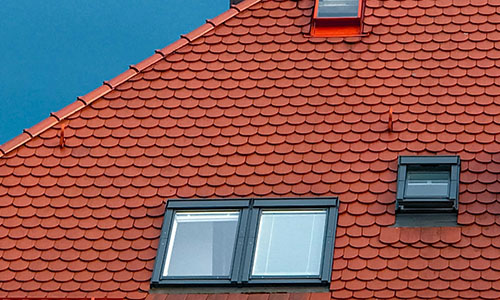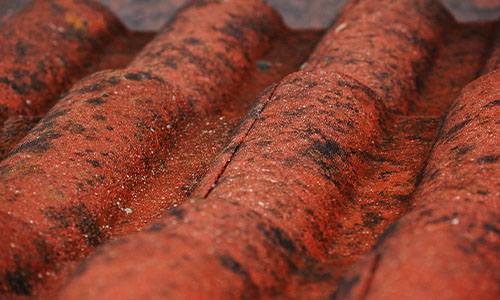Roofing is a critical element of any home, protecting us from the elements and providing shelter. Over the years, tile roofing has gained popularity for its durability, aesthetic appeal, and longevity. However, along with its rise in popularity, several myths and misconceptions about tile roofing have taken root. In this blog post, we’ll explore and debunk these common myths, arming you with the knowledge to make informed roofing decisions.
Myth 1: Tile Roofing is Too Heavy
Heaviness is one of the most common tile roofing myths. Tile roofing is well within the structural capacity of most homes. The primary materials used for tile roofing, such as concrete and clay tiles, typically weigh between 600 to 1,200 pounds per square (100 square feet). This weight range is comparable to many common roofing materials, dispelling the notion of excessive heaviness.

Furthermore, residential structures are generally designed to withstand the load of tile roofing. Professional roofers assess your home’s specific needs during installation, ensuring the structural integrity remains intact. As such, tile roofing proves to be a secure and viable choice for the majority of homeowners, offering durability and aesthetic appeal.
Myth 2: Tile Roofing is Fragile and Easily Damaged
Another of the common tile roofing myths is that it is fragile and susceptible to damage from various sources, including hail, falling branches, and foot traffic. Let’s examine the facts.
Firstly, the materials used in tile roofing, such as concrete, clay, or slate, are inherently robust. They are designed to withstand the test of time, resist wear and tear, and endure exposure to the elements. These materials are also highly fire-resistant, which adds an extra layer of protection to your home.
Secondly, tile roofing is engineered to excel in various weather conditions. It can endure extreme temperatures, from scorching heat to freezing cold, without deteriorating. In regions prone to heavy rainfall or hail, tile roofing’s impact resistance is a valuable asset, as it can withstand these forces of nature without sustaining significant damage.
Lastly, proper installation plays a crucial role in tile roofing’s durability. When installed by skilled professionals, the tiles are secured firmly, preventing leaks and ensuring long-term stability. Regular inspections and maintenance further contribute to the roof’s lasting performance.
Tile Roofs, however, are not designed to withstand foot-traffic. Roofers walk so that they don’t put all their weight on one tile, because putting all your weight on one tile can break it. This is one of, but not the only reason you should avoid walking on a tile roof.
Myth 3: Tile Roofing is Expensive and Unaffordable

Tile roofing is often considered a premium roofing option, and it’s true that it can come with a higher initial price tag compared to some alternatives. However, when you look at the long-term benefits, tile roofing proves to be a wise investment that more than justifies its cost.
While the upfront expense may seem steep, tile roofing is exceptionally durable and built to last. Many tile materials, including concrete, clay, and slate, have a lifespan that far surpasses that of other roofing options. In fact, well-maintained tile roofs can endure for several decades, sometimes even a century or more.
This longevity translates to significant cost savings over the life of your home. With tile roofing, you won’t have to worry about frequent replacements or repairs that can add up over time with other roofing materials. In essence, the initial investment pays off through years of reliable protection and reduced maintenance expenses. If you would like to know how tile roofing compares to shingle roofing in particular, see our article here.
Myth 4: Tile Roofing is High Maintenance
Tile roofs do require maintenance, as all roofs do, but tiles roofs give you a substantial return for your efforts.
Regular maintenance for a tile roof primarily involves inspecting for loose or damaged tiles, clearing debris from gutters and valleys, and ensuring proper ventilation. These tasks are relatively simple and can be performed periodically to keep your roof in top condition.
However, it’s crucial to pay special attention after severe weather events like storms. High winds and hail can potentially dislodge or crack tiles. Promptly addressing any damage is key to preventing leaks and maintaining the roof’s integrity.
It’s worth noting that compared to some other roofing materials, tile roofs generally require less maintenance. They are highly resistant to rot, insects, and mildew, and they don’t need regular resealing or painting.
If you would like to know more about maintaining a roof, you can see our article about it here.
Myth 5: Tile Roofing is Not Suitable for All Climates
The tile roofing myth that they’re not suitable for extreme climates is simply incorrect. Tile roofs are exceptionally well-suited to handle the scorching heat of Arizona and similar hot climates. These roofs excel in high-temperature environments for several reasons.
Firstly, tile materials such as clay and concrete have natural thermal resistance. They are adept at deflecting and dissipating heat, helping to keep your home cooler during the sweltering Arizona summers. This natural insulation not only enhances comfort but also contributes to energy efficiency, potentially reducing cooling costs.
Secondly, tile roofs are designed to endure prolonged exposure to intense sunlight without deteriorating. They do not fade or degrade quickly under the relentless sun, retaining their color and appearance over the years.
Moreover, tile roofing’s sturdy construction and interlocking design provide additional protection against heat-related issues, such as warping or cracking. This ensures that the roof remains structurally sound and resilient in the face of extreme temperatures.
In summary, tile roofs are an ideal choice for Arizona’s heat, offering effective insulation, durability, and resistance to sun damage. They help maintain a comfortable interior climate and can stand up to the challenging weather conditions of the desert Southwest.
Myth 6: Tile Roofing is Limited in Style and Design

On the contrary, tile roofs come in many styles and colors. Whether you have a modern, Mediterranean, Spanish, colonial, or even a contemporary home, tile roofing can be tailored to complement your specific style preferences.
Tile roofs come in various shapes, colors, and textures, making it possible to achieve the look you desire. For instance, if you have a Spanish-style home, you can opt for traditional terracotta-colored tiles to capture that iconic Mediterranean aesthetic. Alternatively, if your taste leans more towards a sleek and modern design, there are smooth and low-profile tiles available that can seamlessly integrate into a modern architectural setting.
Furthermore, tile roofs offer flexibility in terms of patterns and layouts. You can choose from different installation methods, such as staggered patterns or uniform arrangements, to create unique visual effects that enhance your home’s character.
Myth 7: Tile Roofing is Difficult to Install
Contrary to the tile roofing myth that they are overly complicated to install, tile roofs can be efficiently and effectively installed by skilled professionals. While the installation process does require expertise, it is not unreasonably complex.
Professional roofers, experienced in working with tile roofing materials, undergo specialized training to ensure proper installation. They understand the intricacies of tile roofing, from selecting the appropriate underlayment to securing the tiles firmly in place. This expertise minimizes the risk of installation errors.
Moreover, advancements in roofing technology have made the installation process smoother and more streamlined. Roofers have access to tools and equipment designed specifically for tile roofing, further simplifying the job.
While tile roofing installation may take a bit longer than some other roofing materials due to the careful attention to detail required, it is a manageable process when performed by professionals. The key to a successful installation lies in hiring qualified roofers who can ensure your tile roof is securely and correctly installed, providing you with a durable and reliable roofing solution for years to come. If you’d like to know more about how long an installation process for tile (and other materials) will take see our article about it.
Myth 8: Tile Roofing is Not Eco-Friendly

Contrary to tile roofing myths, these are eco-friendly choices for homeowners looking to reduce their environmental impact. Several factors contribute to the eco-friendliness of tile roofing.
Firstly, many tile roofing materials, such as clay and concrete, are made from abundant and natural resources. This reduces the need for energy-intensive manufacturing processes and minimizes the environmental footprint.
Secondly, tile roofs have impressive longevity, often lasting for several decades or even a century. Their durability means fewer materials end up in landfills, reducing waste. Additionally, the need for frequent roof replacements, a common occurrence with other roofing materials, is significantly reduced.
Furthermore, tile roofing’s reflective properties can contribute to energy efficiency. By reflecting the sun’s rays, tile roofs can help keep homes cooler during hot weather, reducing the demand for air conditioning and energy consumption.
Lastly, at the end of their lifespan, tile roofing materials can often be recycled or repurposed, further decreasing their environmental impact.
In conclusion, tile roofing is a top-tier choice for homeowners. Debunking the tile roofing myths, we find it’s adaptable to diverse climates, architectural styles, and energy-efficient. Despite requiring some maintenance, its longevity and cost-effectiveness shine through. In scorching climates like Arizona, it excels, offering insulation and sun resistance. Moreover, tile roofing is eco-friendly, using natural resources and offering recyclability. In sum, it strikes a balance between aesthetics and resilience, enhancing your home while being budget and planet-friendly.

